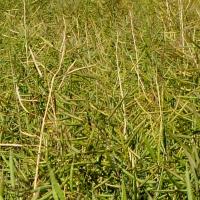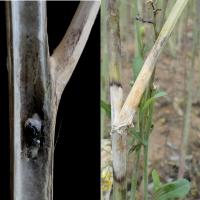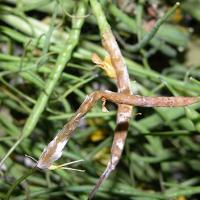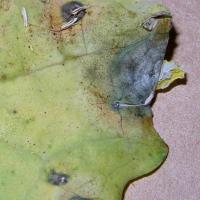Diagnosing sclerotinia stem rot in canola
Sclerotinia stem rot is a fungal disease that causes stem and plant death during flowering.
What to look for
- Bleached or light brown dead plants among green healthy plants after flowering.
Paddock
- Light brown watery discoloured patches on stems, branches and pods that expand and take on a greyish-white colour.
- Lesions girdle the stem causing parts above the lesion to die.
- Hard black bodies called sclerotia are found inside an infected stem when it is split open.
- Plants die prematurely, and often lodge.
- In wet or humid weather, a white growth resembling cotton wool can develop on lesions that may also contain sclerotia.
- Infected pods appear creamish-white in colour and usually contain white mouldy seeds.
Plant
Where did it come from?

Contaminated soil
- Sclerotinia can survive as sclerotia (hard, dark resting bodies) in the soil for many years, and infects plants, such as broadleaf crops, wild radish and capeweed.
- Lupins and chickpeas are commonly infected whereas faba beans and field peas appear to be less susceptible.
- During cool moist weather sclerotia near the surface germinate and produce small, cream, mushroom-like bodies containing many spores. These are carried by the wind to nearby crops.
- Normally the spore must first germinate on, then infect, dead or dying plant material (such as flower petals) before it invades healthy tissues.
- Infected petals that lodge between the stems and leaves are a major infection source. Cool, wet weather favours the disease and mists, dews and fogs provide enough moisture for infection.
- Less commonly, sclerotes directly infect the stem at the surface causing a collar rot that kills the plant.
Management strategies

Spraying fungicide

Cultivation
- Fungicide spray at either 15–30 or 50 per cent bloom may give excellent control of the disease, and is most likely to be economic when:
- Sclerotinia is present in the paddock, or adjacent paddock in the last 3 years.
- Canola or susceptible crops has been grown in the past two years.
- Persistent wet weather at flowering
- Mouldboard ploughing is effective in burying sclerotia provided that it is not repeated within 5 years.
See also
Further information
Where to go for expert help
Page last updated: Friday, 17 April 2015 - 9:15am





